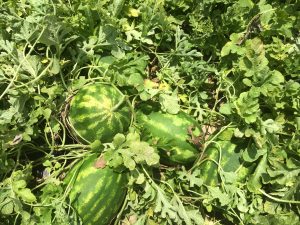By Breanna Kendrick
Depending on where you are, different diseases could affect your watermelons.
Phytophthora, fusarium wilt, anthracnose, downy mildew and gummy stem blight are the biggest issues that Nicholas Dufault, University of Florida associate professor and Extension plant pathologist, has seen. These are the most common diseases in Florida-grown watermelons.
With phytophthora, whole plant death is associated with a lot of excess moisture. If the disease gets to the melons, a white fuzzy fungal growth occurs that can be very devastating to the plants.
Fusarium wilt, as the name implies, wilts the plant. “As the plants get older, we don’t see that wilting as much,” explains Dufault. “It could be due to the temperature, host resistance or it could be that the pathogen is no longer active at that point in time. Usually when the plants are younger, you’ll see that the wilt starts on one side of the plant first. Within a day or two, the rest of the plant will die with fusarium wilt.”
Gummy stem blight and anthracnose have very similar symptoms. Lesions often occur on the leaves and vines. The fungal growth, usually within those lesions, is how you can tell the difference between the diseases. Both gummy stem blight and anthracnose can be very devastating and lead to defoliation.
Anthracnose can sometimes be a dual problem since it can cause damage on the rind and internally.
Downy mildew is a foliar pathogen. “You’ll see a lot of yellowing occurring on the leaves that leads to defoliation,” says Dufault. “This can happen very quickly when it’s wet out there. This will vary depending on your cucurbit hosts. In watermelons, it’s not always going to be the yellow vein limited lesions. Sometimes there will be some brown spots associated with downy mildew in watermelons.”
Dufault says the best management practice at this time is to diversify cultivars. “Look for any type of resistance package … related to the disease that you know is currently occurring in your area … Trying to vary your planting dates by a week or two could be useful, especially for fusarium wilt. If there’s an opportunity to delay five to seven days, this could sometimes be the difference in 10 to 15 percent instances of fusarium wilt out in the field.”
It’s also important to pay attention to the weather and monitor for diseases, advises Dufault. If you have questions or concerns, work with a local Extension office or contact specialists.
“We also always want to recommend rotating your crop,” says Dufault. “Trying to rotate the crop as much as possible is something a lot of producers practice. They will rotate their crops with a grass crop, soy beans or clay peas. These are all great rotational crops for watermelons.”
Dufault recommends an integrated pest management approach. “There is no one solution to it. Fungicides should come in as part of a seasonal program and hopefully can be adjusted during the season based on the diseases that are present.”
Share this Post









